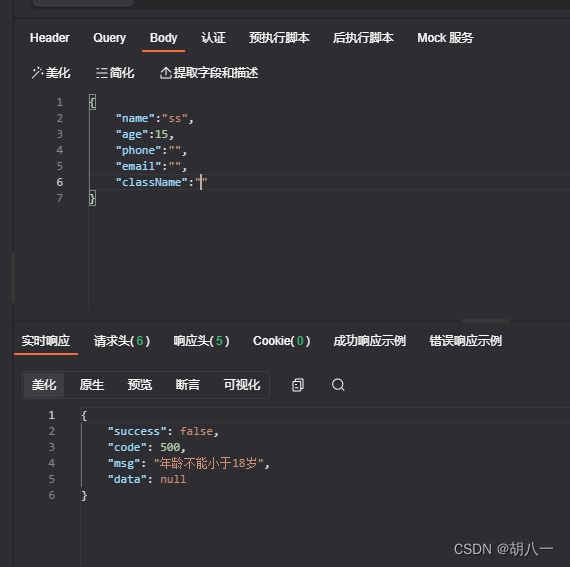Springboot @Validated和@Valid的区别
概述
-
@Valid是使用
Hibernate validation的时候使用 -
@Validated是只用
Spring Validator校验机制使用
说明:java的JSR303声明了@Valid这类接口,而Hibernate-validator对其进行了实现
@Validation对@Valid进行了二次封装,在使用上并没有区别,但在分组、注解位置、嵌套验证等功能上有所不同,这里主要就这几种情况进行说明。
注解位置
-
@Validated:用在类型、方法和方法参数上。但不能用于成员属性(field)
-
@Valid:可以用在方法、构造函数、方法参数和成员属性(field)上
如:

如果@Validated注解在成员属性上,则会报不适用于field错误
分组校验
-
@Validated:提供分组功能,可以在参数验证时,根据不同的分组采用不同的验证机制 -
@Valid:没有分组功能
举例:
定义分组接口:
public interface IGroupA {
}
public interface IGroupB {
定义需要检验的参数bean:
public class StudentBean implements Serializable{
@NotBlank(message = "用户名不能为空")
private String name;
//只在分组为IGroupB的情况下进行验证
@Min(value = 18, message = "年龄不能小于18岁", groups = {IGroupB.class})
private Integer age;
@Pattern(regexp = "^((13[0-9])|(14[5,7,9])|(15([0-3]|[5-9]))|(166)|(17[0,1,3,5,6,7,8])|(18[0-9])|(19[8|9]))\\d{8}$", message = "手机号格式错误")
private String phoneNum;
@Email(message = "邮箱格式错误")
private String email;
@MyConstraint
private String className;
全局异常处理通用返回结果:
public class AjaxResult {
//是否成功
private Boolean success;
//状态码
private Integer code;
//提示信息
private String msg;
//数据
private Object data;
public AjaxResult() {
}
//自定义返回结果的构造方法
public AjaxResult(Boolean success,Integer code, String msg,Object data) {
this.success = success;
this.code = code;
this.msg = msg;
this.data = data;
}
//自定义异常返回的结果
public static AjaxResult defineError(BusinessException de){
AjaxResult result = new AjaxResult();
result.setSuccess(false);
result.setCode(de.getErrorCode());
result.setMsg(de.getErrorMsg());
result.setData(null);
return result;
}
//其他异常处理方法返回的结果
public static AjaxResult otherError(ErrorEnum errorEnum){
AjaxResult result = new AjaxResult();
result.setMsg(errorEnum.getErrorMsg());
result.setCode(errorEnum.getErrorCode());
result.setSuccess(false);
result.setData(null);
return result;
}
public static AjaxResult otherError(String msg, Integer code){
AjaxResult result = new AjaxResult();
result.setMsg(msg);
result.setCode(code);
result.setSuccess(false);
result.setData(null);
return result;
}
public Boolean getSuccess() {
return success;
}
public void setSuccess(Boolean success) {
this.success = success;
}
public Integer getCode() {
return code;
}
public void setCode(Integer code) {
this.code = code;
}
public String getMsg() {
return msg;
}
public void setMsg(String msg) {
this.msg = msg;
}
public Object getData() {
return data;
}
public void setData(Object data) {
this.data = data;
}
}
自定义异常
public class BusinessException extends RuntimeException{
private static final long serialVersionUID = 1L;
/**
* 错误状态码
*/
protected Integer errorCode;
/**
* 错误提示
*/
protected String errorMsg;
public BusinessException(){
}
public BusinessException(Integer errorCode, String errorMsg) {
this.errorCode = errorCode;
this.errorMsg = errorMsg;
}
public Integer getErrorCode() {
return errorCode;
}
public void setErrorCode(Integer errorCode) {
this.errorCode = errorCode;
}
public String getErrorMsg() {
return errorMsg;
}
public void setErrorMsg(String errorMsg) {
this.errorMsg = errorMsg;
}
}
异常类枚举:
public enum ErrorEnum {
// 数据操作错误定义
SUCCESS(200, "成功"),
NO_PERMISSION(403,"你没得权限"),
NO_AUTH(401,"未登录"),
NOT_FOUND(404, "未找到该资源!"),
INTERNAL_SERVER_ERROR(500, "服务器异常请联系管理员"),
;
/** 错误码 */
private Integer errorCode;
/** 错误信息 */
private String errorMsg;
ErrorEnum(Integer errorCode, String errorMsg) {
this.errorCode = errorCode;
this.errorMsg = errorMsg;
}
public Integer getErrorCode() {
return errorCode;
}
public String getErrorMsg() {
return errorMsg;
}
}
全局异常处理类:
@RestControllerAdvice
public class GlobalExceptionHandler {
private static final Logger log = LoggerFactory.getLogger(GlobalExceptionHandler.class);
/**
* 处理自定义异常
*
*/
@ExceptionHandler(value = BusinessException.class)
public AjaxResult bizExceptionHandler(BusinessException e) {
log.error(e.getMessage(), e);
return AjaxResult.defineError(e);
}
@ExceptionHandler(value = MethodArgumentNotValidException.class)
public AjaxResult exceptionHandler( MethodArgumentNotValidException e) {
log.error(e.getMessage(), e);
return AjaxResult.otherError(e.getFieldError().getDefaultMessage(),500);
}
/**
*处理其他异常
*
*/
@ExceptionHandler(value = Exception.class)
public AjaxResult exceptionHandler( Exception e) {
log.error(e.getMessage(), e);
return AjaxResult.otherError(ErrorEnum.INTERNAL_SERVER_ERROR);
}
}
自定义校验注解MyConstraint
//定义注解可加在那些内容上
@Target({ElementType.METHOD,ElementType.FIELD})
//运行时注解
@Retention(RetentionPolicy.RUNTIME)
//校验逻辑提供类
@Constraint(validatedBy = MyConstraintValidator.class)
public @interface MyConstraint {
//校验注解必须有的三个属性
java.lang.String message() default ""; //校验不通过所返回的信息
java.lang.Class<?>[] groups() default {};
java.lang.Class<? extends javax.validation.Payload>[] payload() default {};
}
写一个类定义校验注解使用的逻辑MyConstraintValidator
//校验器逻辑,可注入spring的bean
public class MyConstraintValidator implements ConstraintValidator<MyConstraint,Object> {
@Override
public void initialize(MyConstraint myConstraint) {
//初始化
System.out.println("my validator init");
}
@Override
public boolean isValid(Object value, ConstraintValidatorContext constraintValidatorContext) {
//校验逻辑
System.out.println(value);
//校验通过返回true ,校验不通过返回false
return !StringUtils.isEmpty(value);
}
}
测试代码:
检验分组为IGroupA的情况
@RestController
public class CheckController {
@PostMapping("stu")
public String addStu(@Validated({IGroupA.class}) @RequestBody StudentBean studentBean){
return "add student success";
}
{
"name":"zhuabyi",
"age":15,
"phone":"18782658571",
"email":"[email protected]",
"claseeName":"Test"
}
再改成这样:
@PostMapping("stu")
public String addStu(@Validated({IGroupB.class, Default.class}) @RequestBody StudentBean studentBean){
log.info("studentBean:{}",studentBean);
return "add student success";
}
如果把测试代码改成下面这样,看看测试结果
@RestController
public class CheckController {
@PostMapping("stu")
public String addStu(@Validated({IGroupA.class, IGroupB.class}) @RequestBody StudentBean studentBean){
return "add student success";
}
}
说明:
-
不分 配groups,默认每次都要进行验证
-
对一个参数需要多种验证方式时,也可通过分配不同的组达到目的。
-
@Validated注解指定了分组,只会走该分组的校验,没有或者是其他组的校验则不会走,若要进行验证的话要加上
Default.class。
组序列:
默认情况下 不同级别的约束验证是无序的,但是在一些情况下,顺序验证却是很重要。
一个组可以定义为其他组的序列,使用它进行验证的时候必须符合该序列规定的顺序。在使用组序列验证的时候,如果序列前边的组验证失败,则后面的组将不再给予验证,
举例:
定义组序列:
@GroupSequence({Default.class, IGroupA.class, IGroupB.class})
public interface IGroup {
}
需要校验的Bean,分别定义IGroupA对age进行校验,IGroupB对className进行校验:
public class StudentBean implements Serializable{
@NotBlank(message = "用户名不能为空")
private String name;
@Min(value = 18, message = "年龄不能小于18岁", groups = IGroupA.class)
private Integer age;
@Pattern(regexp = "^((13[0-9])|(14[5,7,9])|(15([0-3]|[5-9]))|(166)|(17[0,1,3,5,6,7,8])|(18[0-9])|(19[8|9]))\\d{8}$", message = "手机号格式错误")
private String phoneNum;
@Email(message = "邮箱格式错误")
private String email;
@MyConstraint(groups = IGroupB.class)
private String className;
测试:
@RestController
public class CheckController {
@PostMapping("stu")
public String addStu(@Validated({IGroup.class}) @RequestBody StudentBean studentBean){
return "add student success";
}
}
测试发现,如果age出错,那么对组序列在IGroupA后的IGroupB不进行校验,即例子中的className不进行校验,结果如下:
嵌套校验:
一个待验证的pojo类,其中还包含了待验证的对象,需要在待验证对象上注解@Valid,才能验证待验证对象中的成员属性,这里不能使用@Validated。
举例:
需要约束校验的bean:
@Data
public class TeacherBean {
@NotEmpty(message = "老师姓名不能为空")
private String teacherName;
@Min(value = 1, message = "学科类型从1开始计算")
private int type;
}
@Data
public class StudentBean implements Serializable {
@NotBlank(message = "用户名不能为空")
private String name;
//只在分组为IGroupB的情况下进行验证
@Min(value = 18, message = "年龄不能小于18岁", groups = {IGroupA.class})
private Integer age;
@Pattern(regexp = "^((13[0-9])|(14[5,7,9])|(15([0-3]|[5-9]))|(166)|(17[0,1,3,5,6,7,8])|(18[0-9])|(19[8|9]))\\d{8}$", message = "手机号格式错误")
private String phoneNum;
@Email(message = "邮箱格式错误")
private String email;
@MyConstraint(groups = IGroupB.class, message = "className不能为空")
private String className;
@NotNull(message = "任课老师不能为空")
@Size(min = 1, message = "至少有一个老师")
private List<TeacherBean> teacherBeans;
}
注意:
这里对teacherBeans只校验了NotNull, 和 Size,并没有对teacher信息里面的字段进行校验,具体测试如下:

这里teacher中的type明显是不符合约束要求的,但是能检测通过,是因为在student中并没有做 嵌套校验
可以在teacherBeans中加上 @Valid,具体如下:
@Valid
@NotNull(message = "任课老师不能为空")
@Size(min = 1, message = "至少有一个老师")
private List<TeacherBean> teacherBeans;







